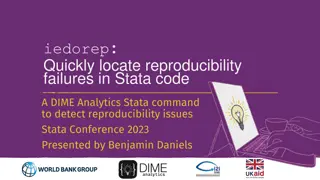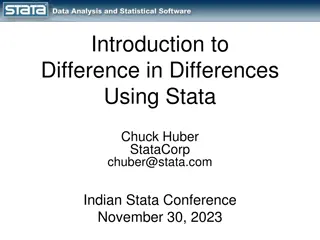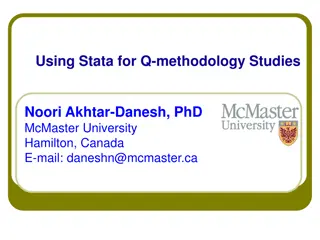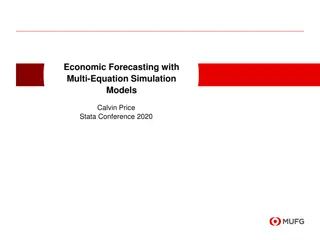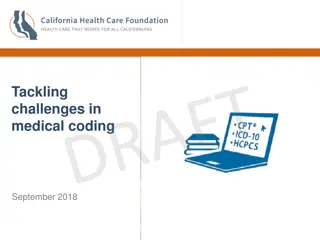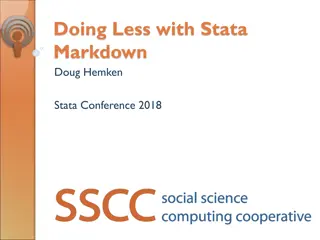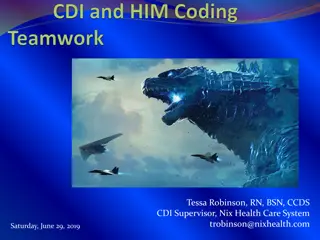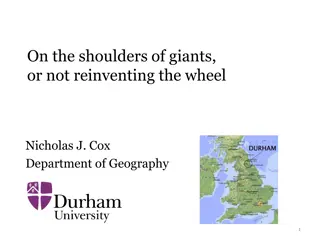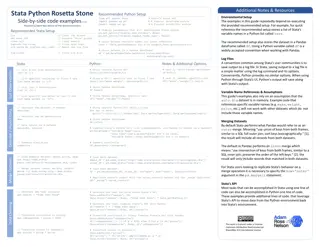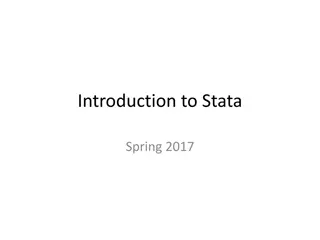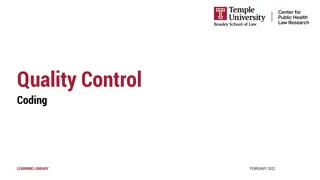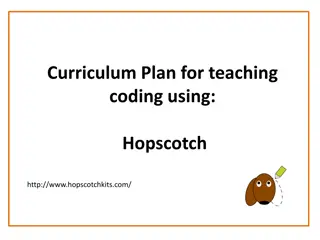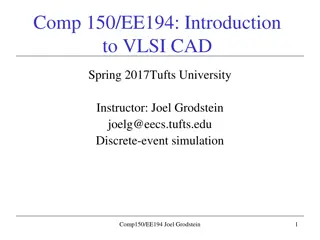Coding Simulation Studies in Stata: A Practical Approach
Understanding simulation studies and their importance in evaluating statistical methods, this presentation delves into the precise coding techniques required in Stata to generate simulated datasets, produce estimates, and analyze performance metrics. With a focus on consistent terminology, data-generating mechanisms, and key datasets involved, the talk provides insights into common errors and a simple simulation study example to illustrate the process.
Download Presentation

Please find below an Image/Link to download the presentation.
The content on the website is provided AS IS for your information and personal use only. It may not be sold, licensed, or shared on other websites without obtaining consent from the author. Download presentation by click this link. If you encounter any issues during the download, it is possible that the publisher has removed the file from their server.
E N D
Presentation Transcript
The Right Way to code simulation studies in Stata Tim Morris MRC CTU at UCL 25th UK Stata Conference Michael Crowther University of Leicester
https://github.com/tpmorris/TheRightWay MRC CTU at UCL
What is a simulation study? Use of (pseudo) random numbers to produce data from some distribution to help us to study properties of a statistical method. An example: 1. Generate data from a distribution with parameter 2. Apply analysis method to data, producing an estimate ? 3. Repeat (1) and (2) nsimtimes 4. Compare with E[ ?] if we had not generated the data, we would not know and so could not do this. MRC CTU at UCL
Some background Consistent terminology with definitions ADEMP (Aims, Data-generating mechanisms, Estimands, Methods, Performance measures): D, E, M are important in coding simulation studies MRC CTU at UCL
Four datasets (possibly) Simulated: e.g. a simulated hypothetical study) Estimates: some summary of a repetition States: record of ????+ 1 RNG states at the beginning of each repetition and one after final repetition Performance: summarises estimates of performance (bias, empirical SE, coverage etc.), and (hopefully) their Monte Carlo SE, for each D, E, M MRC CTU at UCL
This talk This talk focuses on the code that produces a simulated dataset and returns the estimates and states datasets. I teach simulation studies a lot. Errors in coding occur primarily in generating data in the way you want, and in storing summaries of each rep (estimates data). MRC CTU at UCL
A simple simulation study: Aims Suppose we are interested in the analysis of a randomised trial with a survival outcome and unknown baseline hazard function. Aim to evaluate the impacts of: 1. misspecifying the baseline hazard function on the estimate of the treatment effect 2. fitting a more complex model than necessary 3. avoiding the issue by using a semiparametric model MRC CTU at UCL
Data generating mechanisms Simulate nobs=100 and then nobs=500 from a Weibull distribution with ??~????(.5) and ? = ???? 1exp ??? where ? = 0.1,? = 0.5 (admin censoring at 5 years) Study ? = 1 then ? = 1.5 MRC CTU at UCL
Estimands and Methods The estimand is ?, the hazard ratio for treatment vs. control Methods: 1. Exponential model 2. Weibull model 3. Cox model (Don t need to consider performance measures for this talk; see London Stata Conference 2020!) MRC CTU at UCL
Well-structured estimates (empty) Long long format rep_id 1 1 1 1 1 1 1 1 1 1 1 1 n_obs 100 100 100 100 100 100 500 500 500 500 500 500 truegamma =1 =1 =1 =1.5 =1.5 =1.5 =1 =1 =1 =1.5 =1.5 =1.5 method Exponential Weibull Cox Exponential Weibull Cox Exponential Weibull Cox Exponential Weibull Cox theta_hat -1.690183 -1.712495 -1.688541 -.5390697 -.6375546 -.6162164 -.5785365 -.5820988 -.5867053 -.4040936 -.4308287 -.4335943 se .5477225 .54808 .5481199 .2495417 .2504361 .2510851 .1548867 .1549543 .1550035 .1188226 .1189563 .1190354 Inputs Results MRC CTU at UCL
Well-structured estimates (empty) Wide long format rep_id 1 1 1 1 2 2 2 2 n_obs 100 100 500 500 100 100 500 500 gamma theta_exp -1.690183 -.5164924 -.6253604 -.478514 -.377425 -.4841157 -.6477997 -.3358569 se_exp .5477225 .2589072 .1511858 .1176905 .3562627 .2456835 .1615617 .1222584 theta_wei -1.712495 -.5594682 -.6269046 -.5447887 -.3859514 -.5684879 -.6477113 -.3609435 se_wei .54808 .2595417 .1512856 .1179448 .3563656 .2466851 .161647 .1223288 theta_cox -1.688541 -.5601631 -.6343831 -.5460246 -.3728753 -.5850977 -.6452857 -.3619137 se_cox .5481199 .2598854 .1513485 .1180312 .3564457 .2472228 .1616655 .1224012 =1 1.5 =1 1.5 =1 1.5 =1 1.5 Inputs Results MRC CTU at UCL
The simulate approach From the help file: simulate eases the programming task of performing Monte Carlo-type simulations questionable to no . MRC CTU at UCL
The simulate approach If you haven t used it, simulate works as follows: 1. You write a program (rclass or eclass) that follows standard Stata syntax and returns quantities of interest as scalars. 2. Your program will generate 1 simulated dataset and return estimates for 1 estimands obtained by 1 methods. 3. You use simulate to repeatedly call the program. MRC CTU at UCL
The simulate approach I ve wished-&-grumbled here and on Statalist that simulate: Does not allow posting of the repetition number (an oversight?) Precludes putting strings into the estimates dataset, meaning non-numerical inputs (D) and contents of c(rngstate) cannot be stored. Produces ultra-wide data (if E, M and D vary, the resulting estimates must be stored across a single row!) Your code is clean; your estimates dataset is a mess. MRC CTU at UCL
The post approach Structure: tempname tim postfile `tim' int(rep) str5(dgm estimand) /// double(theta se) using estimates.dta, replace forval i = 1/`nsim' { <1st DGM> <apply method> post `tim' (`i') ("thing") ("theta") (_b[trt]) (_se[trt]) <2nd DGM> } postclose `tim' MRC CTU at UCL
The post approach + No shortcomings of simulate + Produces a well-formed estimates dataset post commands become entangled in the code for generating and analysing data post lines are more error prone. Suppose you are using different n. An efficient way to code this is to generate a dataset (with n observations) and then increase subsets of this data in analysis for the smaller n data-generating mechanisms. The code can get inelegant and you mis- post. Your estimates dataset is clean; your code is a mess. MRC CTU at UCL
The right approach One can mash-up the two! 1. Write a program, as you would with simulate 2. Use postfile 3. Call the program 4. Post inputs and returned results using post 5. Use a second postfile for storing rngstates Why? 1. Appease Michael: Tidy code that is less error-prone. 2. Appease Tim: Tidy estimates (and states) dataset that avoids error-prone reshaping & formatting acrobatics. MRC CTU at UCL
A query (grumble?) None of the options allow for a well-formatted dataset. I want to define a (unique) sort order, label variables & values, use chars (for value labels, order matters; see below) I believe this stuff has to be done afterwards (?) To use 1 "Exponential" 2 "Weibull" and 3 "Cox" (I do), I have to open estimates.dta, label define and label values. Could this be done up-front so you could e.g. fill in DGM codes with Cox :method_label rather than number 2? MRC CTU at UCL


